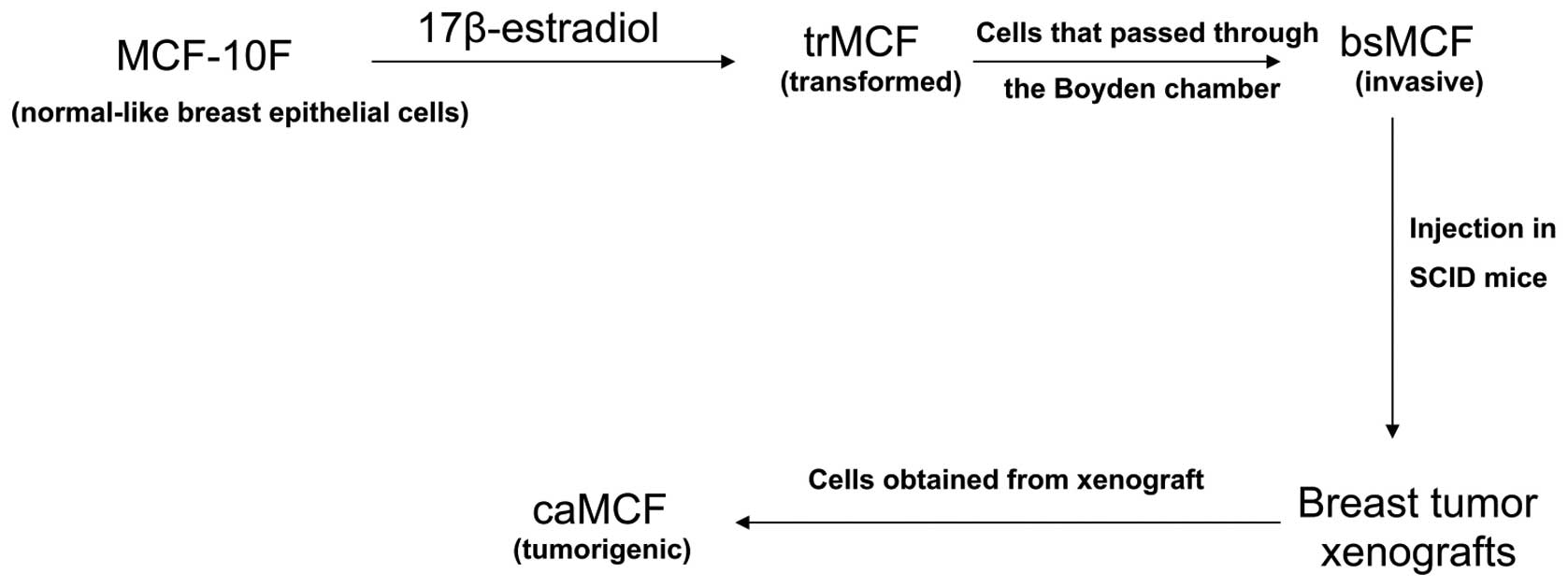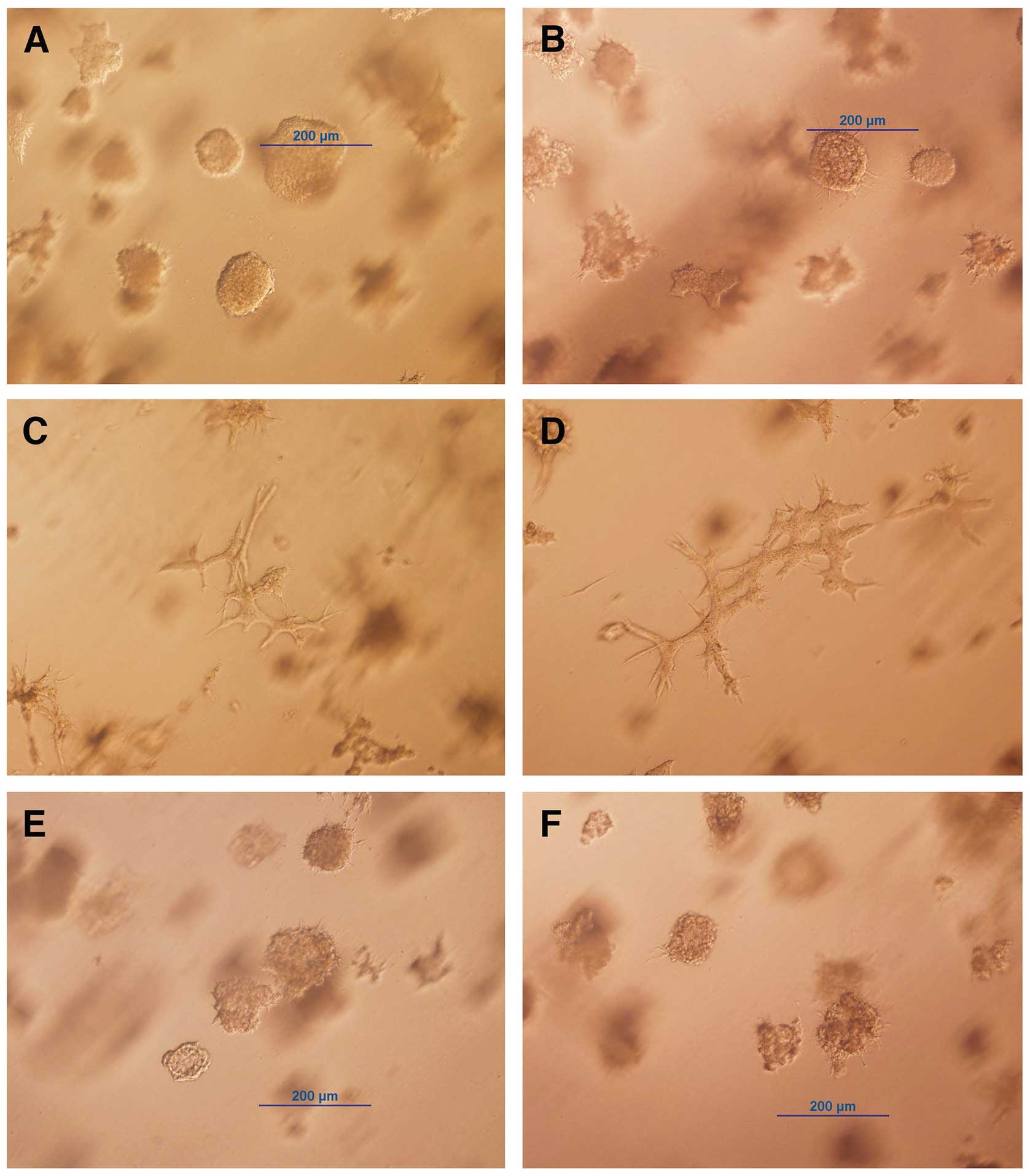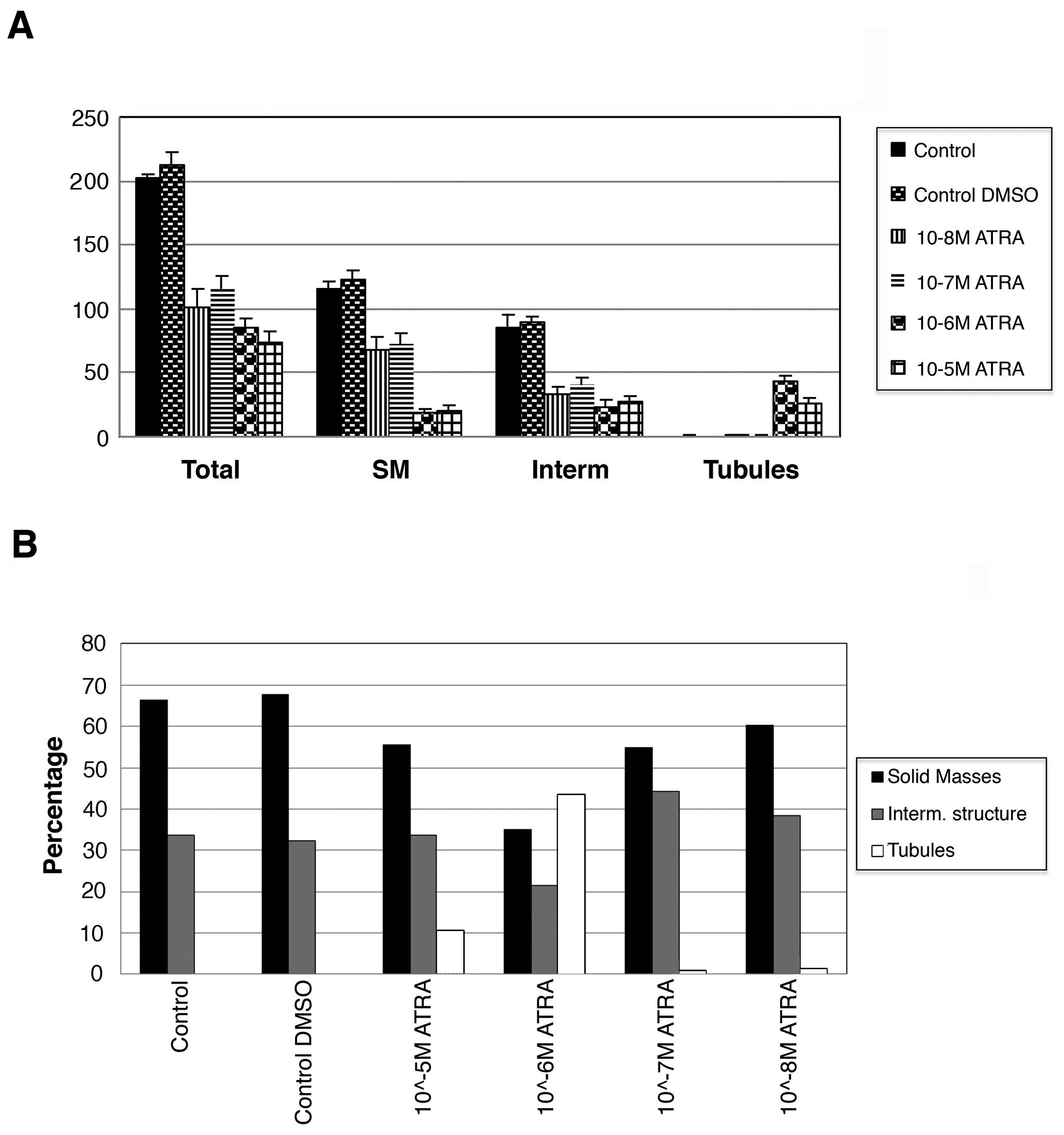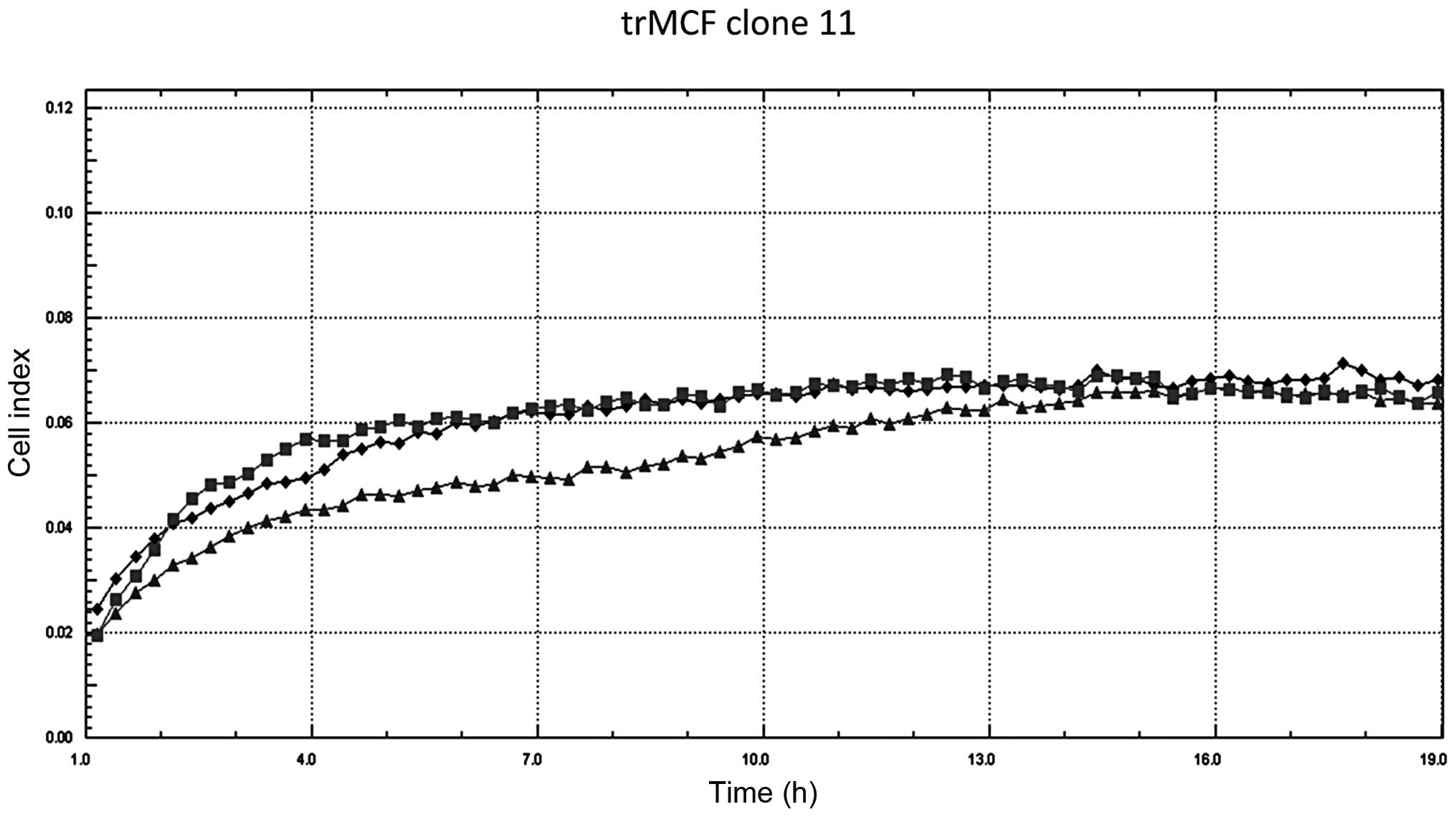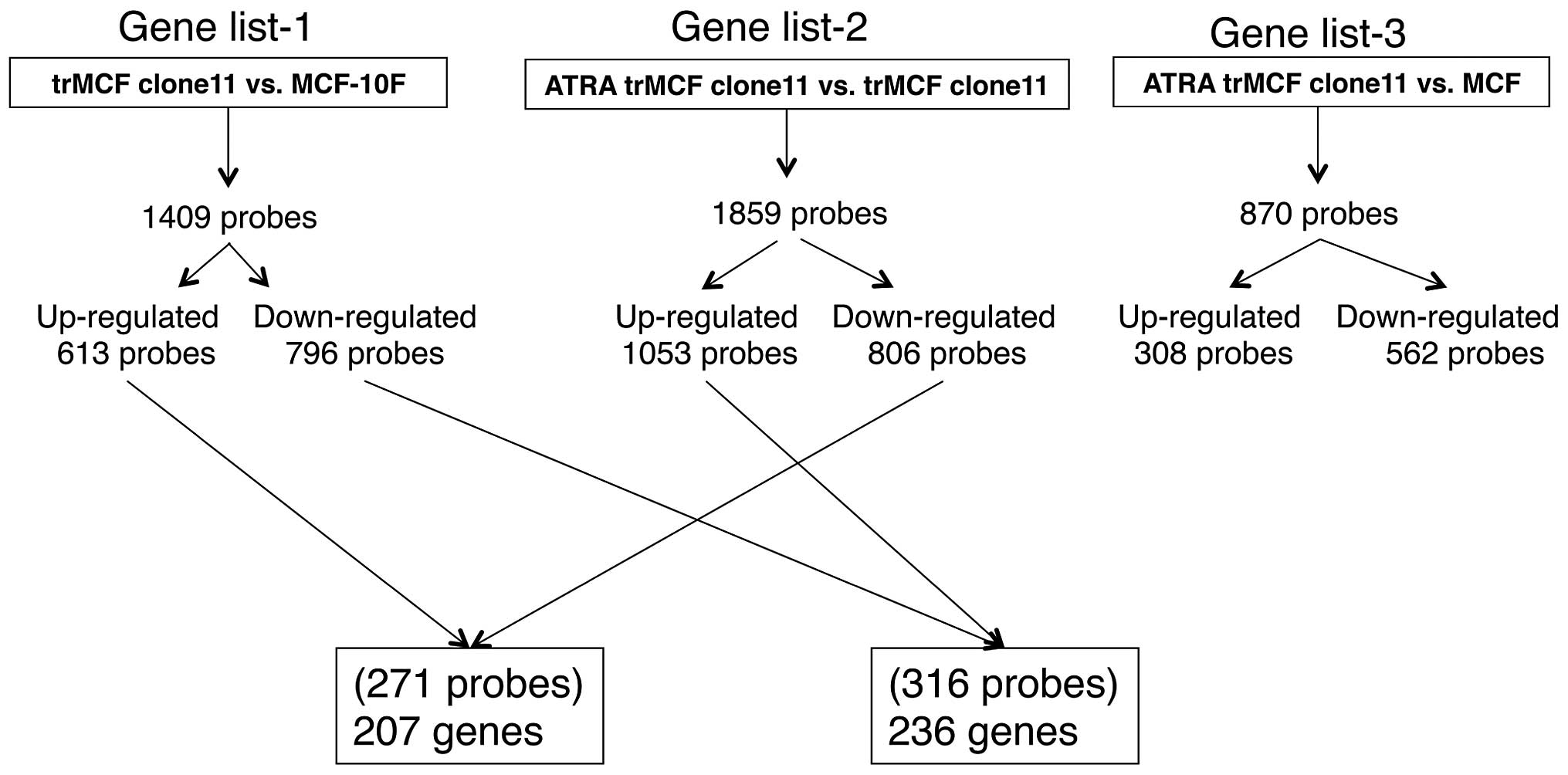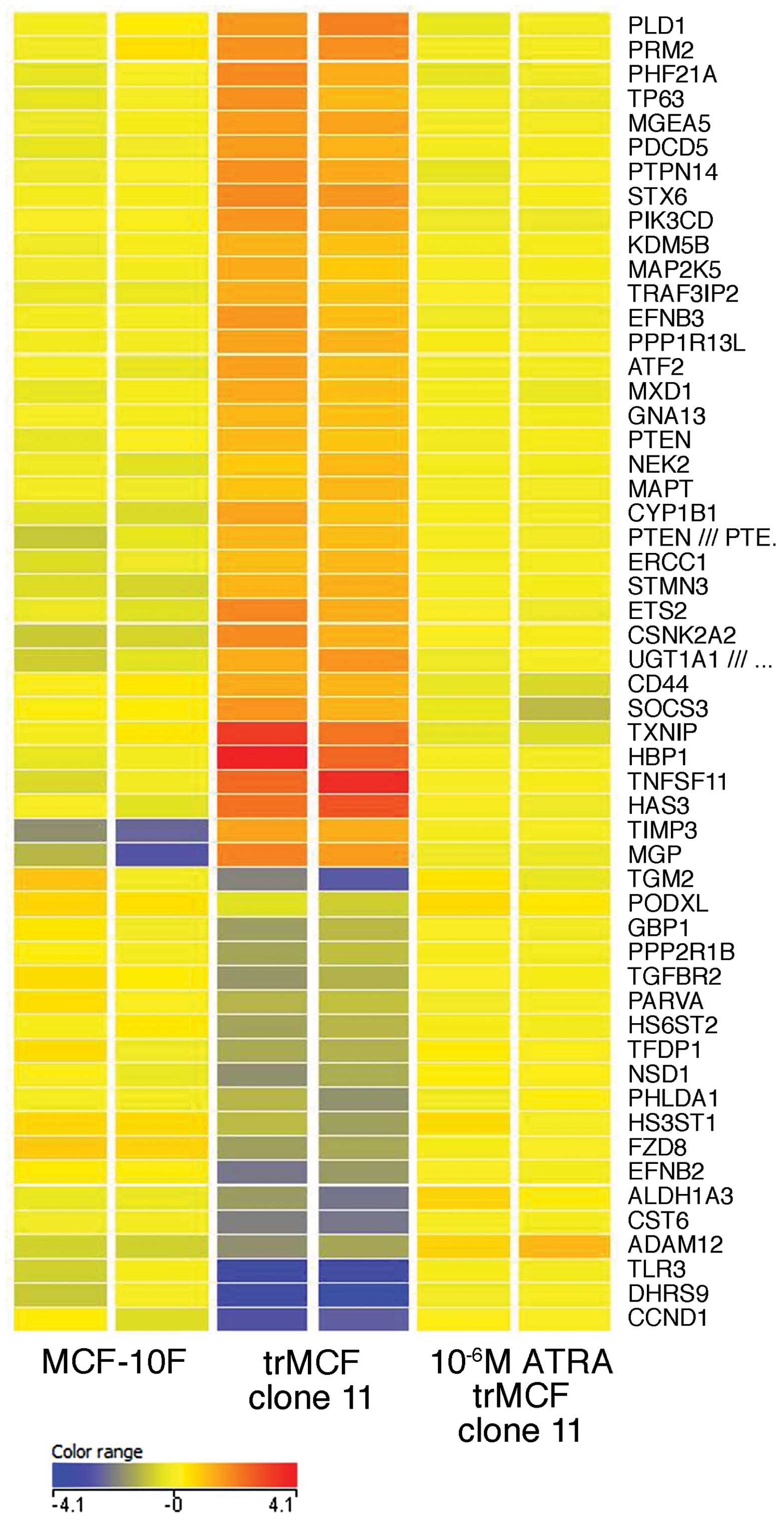All trans-retinoic acid (ATRA) induces re-differentiation of early transformed breast epithelial cells
- Authors:
- Published online on: March 21, 2014 https://doi.org/10.3892/ijo.2014.2354
- Pages: 1831-1842
-
Copyright: © Arisi et al. This is an open access article distributed under the terms of Creative Commons Attribution License [CC BY_NC 3.0].
Abstract
Introduction
Vitamin A is obtained through the diet in the form of retinol, retinyl ester or β-carotene (1). Retinoic acid (RA) is one of the principal active metabolites of vitamin A which plays a critical role in cell proliferation, differentiation and apoptosis in normal tissues during embryonic development (2). RA induces differentiation in many cell types and is the most widely used differentiating therapeutic agent (3,4). Retinol has 6 biologically active isoforms that among others includes all-trans (ATRA, tretinoin) and 9-cis RA (alitretinoin); ATRA is the predominant physiological form (5). RA mediates the transcriptional regulation of several genes by binding to the nuclear retinoic acid receptors (RARs), namely RARα, RARβ and RARγ (6,7). Like other nuclear receptors, RARs contain a domain that mediates interaction with ATRA, a zinc finger-containing DNA binding domain that binds to RA response elements (RAREs) in target genes, and a dimerization domain that engages members of the retinoid X receptor (RXR) subfamily in RXR/RAR heterodimers (8). Different isomers activate different receptors and thus lead to different biological effects. RARs can be activated by both all-trans (ATRA) and 9-cis-RA, while RXR are exclusively activated by 9-cis RA; however, due to the conversion of ATRA to 9-cis RA, high concentrations (10−5 M) of ATRA can also activate gene transcription in cells transfected with RXRs (9). It has also been shown that retinoids exert their effects via the nuclear receptor independent pathway (5).
RA and its derivatives are promising anti-neoplastic agents endowed with both therapeutic and chemopreventive potential because they are able to regulate cell growth, differentiation and apoptosis (10,11). It is believed that the anti-neoplastic pathways induced by RA are regulated predominantly by RAR-β, which is known to induce apoptosis; thus it has been suggested that RAR-β plays a critical role in mediating the growth arrest and differentiation in several breast cancer cell types (12–14).
We have developed an in vitro-in vivo model of breast cancer progression by treating the human normal-like breast epithelial cells MCF-10F with a high dose of estradiol (70 nM) (Fig. 1) (15,16). This model consists of four cell lines: i) the spontaneously immortalized cell line MCF-10F, which is considered to be a normal-like breast epithelial cell line; ii) the transformed trMCF cells; iii) the invasive bsMCF cells; and iv) cells isolated from xenografts, caMCFs, which show all characteristics of fully malignant breast cancer cells (Fig. 1). Gene expression studies showed the highest number of deregulated genes in caMCF, being slightly lower in bsMCF, and lowest in trMCF and, this order was consistent with the extent of chromosome aberrations (caMCF>bsMCF>>trMCF) (16). This model of breast cancer progression resembles the different steps of neoplastic transformation of the mammary gland; it is widely held that breast cancer initiates as the premalignant stage of atypical ductal hyperplasia (ADH), progresses into the pre-invasive stage of ductal carcinoma in situ (DCIS), and culminates in the potentially lethal stage of invasive ductal carcinoma (IDC) (17). In collagen, the normal-like MCF-10F cells form tubules resembling the structures observed in the normal mammary gland although after treatment with estradiol, the transformed trMCF cells form tubules and spherical masses, which are indicative of cell transformation (8,19). The spherical masses showed a partial filling of the lumen that would result from decreased central apoptosis, enhanced cellular proliferation or both (18). The filling of the lumen of the tubular structures of the breast is the earliest morphologic alteration and is common in atypical ductal hyperplasia and ductal carcinoma in situ (DCIS) (18). In the presented study, we studied the effect of all trans-RA (ATRA) using this model of breast cancer progression. Our results showed that ATRA was able to re-program early transformed cells to a normal stage.
Materials and methods
Cells and media
The human normal-like breast epithelial cells MCF-10F are estrogen receptor (ER) negative, progesterone receptor (PR) negative and HER2 negative. Cells were cultured in Dulbecco’s modified Eagle’s medium [DMEM/F-12, Gibco, Carlsbad, CA; formula 90–5212 EF: containing DMEM/F12 (1:1) with L-glutamine and phenol red, D-glucose 315 mg/l, sodium pyruvate 55 mg/l] with 5% horse serum, 2.43 g/l sodium bicarbonate, 20 mg/l epidermal growth factor (EGF), 100 mg/l Vibrio cholerae toxin, 10 mg/l insulin, 0.5 mg/l hydrocortisone, 1.05 mM calcium, antibiotics and antimicotic (100 U/ml penicillin, 100 mg/ml streptomycin, 0.25 mg/ml amphotericin). A 10-mM solution of all trans-retinoic acid (ATRA, Cat# R2625, Sigma, St. Louis, MO) was prepared as a stock solution by dissolving ATRA in dimethylsulphoxide (DMSO).
The trMCF clone 11 was isolated by seeding 100–1,000 trMCF cells in a 100-mm cell culture plate and after 1 day in culture, several colonies were isolated by ring cloning. The trMCF clone 11 cells were generated by expanding the cells from one of these colonies; trMCF clone 11 cells only formed spherical masses on collagen. To study the effect of ATRA, trMCF clone 11 cells were treated continuously for 26 days with 10−5 M (10 μM) to 10−8 M (0.01 μM) ATRA (media was replaced daily). As control, the cells were treated with 0.1% DMSO (vehicle). The bsMCF and caMCF cells were treated with 10−5 to 10−8 M ATRA alone or in combination with 2.5 μM 5-aza-dC.
Collagen assays
The cells were resuspended at a final density of 1.5×104 cells/ml in collagen matrix consisting of 2.68 mg/ml (89.3%) type I collagen (PureCol, Inamed Biomaterials Co., Fremont, CA), 8% 12.5X DMEM-F12 with antibiotics, 0.1 mg/ml insulin, 14 mM NaHCO3 and 0.01 N NaOH. A total of 400 μl (3,000 cells) were plated on the top four 24-well chambers pre-coated with 400 μl of 89.3% collagen mix. Per each treatment, cells were plated in 4 wells and fed daily with the medium described before. The structures in collagen matrix were observed daily under an inverted microscope and at the end of the observation period (8 days), the structures (spherical masses, tubules and intermediate structures) were counted, photographed and fixed in 10% neutral buffered formalin and processed for histological examination. Results were expressed as the total number of structures per well (spherical masses, tubules and intermediate structures) and percentage of the different structures per treatment. The t-test was used to determine if the differences were significant.
Invasion assays
Cell invasion in real-time were performed using xCELLigence RTCA DP device from Roche Diagnostics (Mannheim, Germany). For this purpose, each well of the upper chamber of the CIM-Plate 16 was covered with Matrigel (BD Biosciences, Franklin Lakes, NJ) basement membrane matrix (1:20 in cell culture media) and 10% fetal bovine serum (chemo-attractant) was added in the lower chamber. A total of 40,000 cells suspended in 100 μl serum free media were seeded per well in CIM-Plates 16 (Roche Diagnostics). Data acquisition and analysis was performed with the RTCA software (version 1.2, Roche Diagnostics). Changes in impedance from cells that invade and migrate to the underside of wells were recorded and monitored for a total of 24 h.
Gene expression profiling
RNA was isolated from the cells using RiboPure™ kit (Life Technologies, Frederick, MD) and RNA quality was controlled using the Agilent 2100 Bioanalyzer. Gene expression studies were performed using Affymetrix U133 Plus 2.0 (Affymetrix, Santa Clara, CA) human oligonucleotide microarrays containing over 47,000 transcripts and variants, including 38,500 well characterized human genes. After hybridization, the chips were scanned using GeneChip Scanner 3000. The data were analyzed with Microarray Suite version 5.0 (MAS 5.0) using Affymetrix default analysis settings and global scaling as normalization method. The trimmed mean target intensity of each array was arbitrarily set to 100. Background correction and normalization was done using Iterative Plier 16 with GeneSpring V11.5 software (Agilent, Palo Alto, CA). The criteria for differentially expressed genes was set at ≥2-fold changes (p-value <0.05). The differentially expressed gene list was loaded into Ingenuity Pathway Analysis (IPA) 8.0 software (Ingenuity Systems, Redwood City, CA) to perform biological network and functional analyses.
Results
Treatment with ATRA induced branching morphogenesis in early transformed breast epithelial cells
MCF-10F cells are normal-like breast epithelial cells that form tubules in collagen matrix (3D culture); when these cells were treated with high dose of estradiol (70 nM), the cells (trMCF) formed tubules and spherical masses. To isolate transformed cells that only form spherical masses, trMCF cells were seeded at low density in cell culture dishes and several clones were isolated by ring cloning. One of these clones, trMCF clone 11, did not form tubules in collagen; instead these cells formed spherical masses and intermediate structures (Fig. 2A and B). The trMCF clone 11 cells were treated continuously for 26 days with 10−5 to 10−8 M all trans-retinoic acid (ATRA) and, we found that cells treated with 10−5 and 10−6 M ATRA were able to form tubules in collagen (Fig. 2C and D). Furthermore, the spherical masses formed by trMCF clone 11 treated with 10−5 and 10−6 M ATRA (Fig. 2C and D) were smaller compared to the ones formed by the controls (Fig. 2A and B) or cells treated with 10−7 and 10−8 M ATRA (Fig. 2E and F). The trMCF clone 11 cells treated with 10−7 and 10−8 M ATRA (Fig. 2E and F) did not show any difference in morphology when compared to the controls (Fig. 2A and B). The number of spherical masses, intermediate structures and tubules for trMCF clone 11 cells treated with different concentrations of ATRA was counted (Fig. 3). The total number of structures in collagen was significantly lower in cells treated with ATRA compared with the controls suggesting that ATRA treatment decrease the proliferation rate of the cells (p<0.01) (Fig. 3A). The control trMCF clone 11 showed spherical masses and intermediate structures but no tubules in collagen while cells treated with 10−6 and 10−5 M ATRA formed tubules and less spherical masses (Fig. 3A). The cells treated with 10−5 or 10−6 M ATRA formed significantly less spherical masses than the cells treated with 10−7 or 10−8 M ATRA (p<0.01) (Fig. 3A). A total of 43% of the structures were tubules in the wells containing cells treated with 10−6 M ATRA and 10% tubules in wells with 10−5 M ATRA-treated cells (Fig. 3B).
The invasion capacity of trMCF clone 11 was studied before and after ATRA treatment but, no differences were observed (Fig. 4). The bsMCF and caMCF cells did not show any changes in their morphology or invasion capacity after treatment with ATRA alone or in combination with the demethylating agent 5-aza-cytidine (data not shown).
Treatment with ATRA re-programmed gene expression of early transformed cells
As trMCF clone 11 cells that only formed spherical masses on collagen were able to form tubules after treatment with 10−5 or 10−6 M ATRA, gene expression studies were performed on these cells. The microarray data have been deposited into the NCBI gene expression omnibus (GEO) datasets (GSE51549). The unsupervised sample classification by PCoA (principle coordinate analysis) revealed that trMCF clone 11 cells treated with 10−5 or 10−6 M ATRA demonstrated a major difference with trMCF clone 11 cells, and a minor difference with MCF-10F; also sample differences between 10−5 M ATRA and 10−6 M ATRA were weak (Fig. 5). Although, trMCF clone 11 cells treated with 10−5 M ATRA and 10−6 M ATRA showed minor differences at the expression level, we considered trMCF clone 11 treated with 10−6 M ATRA for the expression analysis since the number of tubules in collagen matrix was higher for this concentration (43% tubules with 10−6 M ATRA vs. 10% tubules with 10−5 M ATRA). For gene expression studies, three experimental groups were compared using empirical Bayesian-moderated t-test implemented in R package ‘limma’: the normal breast epithelial cells MCF-10F, the cells transformed by treatment with estradiol trMCF clone 11 (that only formed spherical masses on collagen) and the trMCF clone 11 after treatment with 10−6 M ATRA. We generated three gene lists at criteria of fold change ≥2 and p≤0.05: gene list-1 (trMCF clone11 vs. MCF-10F) with 1,409 probes (613 probes upregulated; 796 probes downregulated), gene list-2 (ATRA trMCF clone 11 vs. trMCF clone 11) with 1,859 probe sets (1,053 probes upregulated; 806 probes downregulated) and gene list-3 (ATRA trMCF clone 11 vs. MCF-10F) with 870 probe sets (308 probes upregulated; 562 probes downregulated) (Fig. 6). Most importantly, 207 genes (271 probes) upregulated in the transformed trMCF clone 11 (compared to the normal MCF-10F) were downregulated after treatment with 10−6 M ATRA (Fig. 6 and Table IA) and 236 genes (316 probes) that were downregulated in trMCF clone 11 (compared to MCF-10F) were upregulated by 10−6 M ATRA treatment (Fig. 6 and Table IB). These 443 genes defined a gene signature programming the reverse-transformation effect by ATRA (Table I). The relatively smaller number of significant probe sets in gene list-3 compared with other gene lists (Fig. 6) further supported the findings that ATRA-treatment reprograms the gene expression status of trMCF clone 11 cells to MCF-10F.
Ingenuity pathway analysis (IPA) revealed 4 canonical pathways significantly dysregulated in the transformed cells trMCF clone 11: aryl hydrocarbon receptor signaling, retinoic acid activation, xenobiotic metabolism signaling and molecular mechanism of cancer (Table II). Several genes of these pathways that were up- or downregulated in trMCF clone 11 show similar levels of expression to MCF-10F after trMCF clone 11 was treated with 10−6 M ATRA (Table II and Fig. 7). Genes from the aryl hydrocarbon receptor signaling ALDH1A3, CCND1, TGFBR2, TGM2 and TFDP1 were downregulated in the transformed cells trMCF clone 11 when compared to their expression in the normal breast epithelial cells MCF-10F and, the expression of these genes was upregulated after these cells were treated with 10−6 M ATRA reaching similar levels to the expression in MCF-10F (Table II and Fig. 7). One of the functions that show enrichment of dysregulated genes in the transformed trMCF clone 11 cells is cell morphology and the expression of most of these genes reached similar levels to MCF-10F after trMCF cells were treated with 10−6 M ATRA. The expression of some genes related to cell morphology such as PLD1, CD44, STX6, STMN3, ATF2, ETS2, NEK2, HAS3, MGP, GNA13 were upregulated in the transformed trMCF clone 11 and their expression reached normal levels after 10−6 M ATRA treatment (Fig. 7); other genes related to cell morphology such as PHLDA1, GBP1, HS6ST2 and TLR3 were downregulated in trMCF clone 11 and their expressions increased after 10−6 M ATRA treatment reaching similar levels to those found in the normal MCF-10F breast epithelial cells (Fig. 7). Also, the expression of several genes that encode enzymes involved in chromatin modifications such as MGEA5, ATF-2, KDM5B, PRMT2 (PRM2), PHF21A and NSD1, were dysregulated in trMCF clone 11, reaching normal levels after 10−6 M ATRA treatment (Fig. 7).
Discussion
In this study we showed that all trans-retinoic acid (ATRA) induced branching of early transformed human breast epithelial cells. The transformed trMCF clone 11 cells form spherical masses in collagen (3D culture) and treatment with 10−6 M ATRA produced a significant decrease in spherical masses and an increased number of tubules. Cells at an advanced stage of transformation (bsMCF and caMCF) did not show any change in morphology after being treated with ATRA. Our previous results showed that RARβ (retinoic acid receptor β) was unmethylated in MCF-10F and trMCF cells and became hypermethylated at the invasive (bsMCF) and tumorigenic (caMCF) stages (19); although bsMCF and caMCF were treated with 5-aza-dC to reactivate the expression of RARβ in combination with ATRA, no changes in the phenotype of these cells in collagen were observed. Our results indicate that ATRA is able to re-differentiate early transformed cells to a normal stage but, not tumor cells at later stages of the neoplastic process. We previously showed that bsMCF and caMCF had important chromosomal gains and losses and the earlier transformed cells trMCF showed small genomic changes (16); this could explain why ATRA was only effective as a re-differentiation agent in the early transformed breast epithelial cells. Different studies indicate that epigenetic modifications play important roles in RA transcriptional regulation (20–24). Histones have a long N-terminal tail extending outside the nucleosome that is subject to acetylation, phosphorylation, and methylation (25). In the absence of RA, co-repressive elements (SMRT, NCoR and SIN3A) inhibit transcription; the presence of RA releases co-repressors and histone deacetylases allowing chromatin remodeling and access to specific RAREs (20,24). RA treatment leads to acetylation of histones H3 and H4 that lead to a more open stage of the chromatin allowing the transcription of ATRA regulated genes. However, only a limited number of information is currently available on the epigenetic dynamics of RA response.
Recently, analysis of gene expression array datasets of different FDA approved drugs revealed that ATRA (tretinoin) is a drug that is negatively associated with cancer stem cell (CSC) enriched gene expression signature (26). We found that ATRA treatment reduced the expression of the stem cell marker CD44 in early transformed cells. ATRA exerts effects on stem cell differentiation in part via the modulation of the epigenome. Numerous enzymes that alter the modifications on histones are involved in transcriptional activation of specific genes in stem cells, and many of these enzymes are modulated by RA treatment of stem cells (27). The expression of several genes encoding enzymes involved in chromatin modifications such as MGEA5, ATF-2, KDM5B, PRMT2, PHF21A and NSD1 were dysregulated in trMCF clone 11, reaching normal levels after ATRA treatment. Others have shown that in breast cancer, retinoids are effective inhibitors of breast cancer cells at early stages of tumor progression, but their effectiveness diminishes as the tumors become more aggressive (28). Our results support these findings.
Our results show that the RA concentration is important to induced re-differentiation of early transformed breast epithelial cells. The treatment of transformed cells with either 10−7 or 10−8 M ATRA did not induced any change in morphology although, cells were able to form tubules after treatment with 10−5 and 10−6 M ATRA, more tubules being developed after treatment with 10−6 M (1 μM) ATRA.
Little is known about the genomic targets and effects of the different isoforms of the RARs and mechanism or extent of crosstalk between RA signaling and other signaling pathways. It has been recently shown that RAR binding through the genome is highly coincident with estrogen receptor α binding, resulting in widespread crosstalk of RA and estrogen signaling to antagonistically regulate breast-cancer associated genes (29). Our gene expression studies determined 443 genes which defined a signature of ATRA re-programming effect in early transformed breast epithelial cells; these genes were dysregulated in the early transformed cells and they reached normal levels after the cells were treated with 10−6 M ATRA. Genes from the aryl hydrocarbon receptor (AhR), retinoic acid receptor (RAR) and the xenobiotic pathways were dysregulated in the early transformed breast epithelial cells and their expression reached normal levels after ATRA treatment. It has been shown that there is an interaction between AhR and RAR activation and that AhR not only binds to polycyclic aromatic hydrocarbon family of environmental contaminants but also to some synthetic retinoids (30,31).
N-(4-hydoxyphenyl) retinamide (fenretinide or 4HPR) is a synthetic retinoid that is currently one of the most promising clinically tested retinoids. The modification of the carboxyl end of all-trans RA with N-4-hydroxyphenyl group resulted in increased efficacy as a chemoprevention agent as well as reduced toxicity when compared with other retinoids (32). Animal models have demonstrated that treatment with fenretinide prevents chemically induced cancers of the breast, prostate, bladder and skin (33–36).
In conclusion, our results showed that 1 μM ATRA was able to re-differentiate transformed cells at early stages of the neoplastic process and antagonistically regulated breast cancer associated genes. Our results support previous findings that 1 μM ATRA could be used as a chemo-preventive agent to inhibit the progression of premalignant lesions of the breast.
Acknowledgements
We thank Karen Trush for helping in the preparation of the final figures. This study was supported by The Pennsylvania Breast Cancer Coalition and Friends for an Earlier Breast Cancer Test.
References
|
Theodosiou M, Laudet V and Schubert M: From carrot to clinic: an overview of the retinoic acid signaling pathway. Cell Mol Life Sci. 67:1423–1445. 2010. View Article : Google Scholar : PubMed/NCBI | |
|
Duester G: Retinoic acid synthesis and signaling during early organogenesis. Cell. 134:921–931. 2008. View Article : Google Scholar : PubMed/NCBI | |
|
Mongan NP and Gudas LJ: Diverse actions of retinoid receptors in cancer prevention and treatment. Differentiation. 75:853–870. 2007. View Article : Google Scholar : PubMed/NCBI | |
|
Connolly R, Nguyen NK and Sukumar S: Molecular pathways: current role and future directions of the retinoic acid pathway in cancer prevention and treatment. Clin Cancer Res. 19:1651–1659. 2013. View Article : Google Scholar : PubMed/NCBI | |
|
Bushue N and Wan YJ: Retinoid pathway and cancer therapeutics. Adv Drug Deliv Rev. 62:1285–1298. 2010. View Article : Google Scholar : PubMed/NCBI | |
|
Aagaard MM, Siersbaek R and Mandrup S: Molecular basis for gene-specific transactivation by nuclear receptors. Biochim Biophys Acta. 1812.824–835. 2011.PubMed/NCBI | |
|
Tsai MJ and O’Malley BW: Molecular mechanisms of action of steroid/thyroid receptor superfamily members. Annu Rev Biochem. 63:451–486. 1994. View Article : Google Scholar : PubMed/NCBI | |
|
Rochette-Egly C and Germain P: Dynamic and combinatorial control of gene expression by nuclear retinoic acid receptors (RARs). Nucl Recept Signal. 7:e0052009.PubMed/NCBI | |
|
Heyman RA, Mangelsdorf DJ, Dyck JA, et al: 9-cis retinoic acid is a high affinity ligand for the retinoid X receptor. Cell. 68:397–406. 1992. View Article : Google Scholar : PubMed/NCBI | |
|
Garattini E, Gianni M and Terao M: Cytodifferentiation by retinoids, a novel therapeutic option in oncology: rational combinations with other therapeutic agents. Vitam Horm. 75:301–354. 2007. View Article : Google Scholar : PubMed/NCBI | |
|
Zanardi S, Serrano D, Argusti A, Barile M, Puntoni M and Decensi A: Clinical trials with retinoids for breast cancer chemoprevention. Endocr Relat Cancer. 13:51–68. 2006. View Article : Google Scholar : PubMed/NCBI | |
|
Seewaldt VL, Johnson BS, Parker MB, Collins SJ and Swisshelm K: Expression of retinoic acid receptor beta mediates retinoic acid-induced growth arrest and apoptosis in breast cancer cells. Cell Growth Differ. 6:1077–1088. 1995.PubMed/NCBI | |
|
Swisshelm K, Ryan K, Lee X, Tsou HC, Peacocke M and Sager R: Down-regulation of retinoic acid receptor beta in mammary carcinoma cell lines and its up-regulation in senescing normal mammary epithelial cells. Cell Growth Differ. 5:133–141. 1994.PubMed/NCBI | |
|
Widschwendter M, Berger J, Muller HM, Zeimet AG and Marth C: Epigenetic downregulation of the retinoic acid receptor-beta2 gene in breast cancer. J Mammary Gland Biol Neoplasia. 6:193–201. 2001. View Article : Google Scholar : PubMed/NCBI | |
|
Russo J, Fernandez SV, Russo PA, et al: 17-Beta-estradiol induces transformation and tumorigenesis in human breast epithelial cells. FASEB J. 20:1622–1634. 2006. View Article : Google Scholar : PubMed/NCBI | |
|
Huang Y, Fernandez SV, Goodwin S, et al: Epithelial to mesenchymal transition in human breast epithelial cells transformed by 17beta-estradiol. Cancer Res. 67:11147–11157. 2007. View Article : Google Scholar : PubMed/NCBI | |
|
Fernandez SV and Russo J: Estrogen and xenoestrogens in breast cancer. Toxicol Pathol. 38:110–122. 2010. View Article : Google Scholar : PubMed/NCBI | |
|
Hebner C, Weaver VM and Debnath J: Modeling morphogenesis and oncogenesis in three-dimensional breast epithelial cultures. Annu Rev Pathol. 3:313–339. 2008. View Article : Google Scholar : PubMed/NCBI | |
|
Snider KE, Ehya H, Russo J and Fernandez SV: NRG1 and RARB hypermethylation in breast cancer progression. In: Proceedings of the ACCR 102nd Anual Meeting; Orlando, FL.. Cancer Res. 71(Suppl 1): abs. 75. pp. 2011 | |
|
Glass CK and Rosenfeld MG: The coregulator exchange in transcriptional functions of nuclear receptors. Genes Dev. 14:121–141. 2000.PubMed/NCBI | |
|
Hartman HB, Yu J, Alenghat T, Ishizuka T and Lazar MA: The histone-binding code of nuclear receptor co-repressors matches the substrate specificity of histone deacetylase 3. EMBO Rep. 6:445–451. 2005. View Article : Google Scholar : PubMed/NCBI | |
|
Lefebvre B, Ozato K and Lefebvre P: Phosphorylation of histone H3 is functionally linked to retinoic acid receptor beta promoter activation. EMBO Rep. 3:335–340. 2002. View Article : Google Scholar : PubMed/NCBI | |
|
McKenna NJ and O’Malley BW: Combinatorial control of gene expression by nuclear receptors and coregulators. Cell. 108:465–474. 2002. View Article : Google Scholar : PubMed/NCBI | |
|
Rochette-Egly C: Dynamic combinatorial networks in nuclear receptor-mediated transcription. J Biol Chem. 280:32565–32568. 2005. View Article : Google Scholar : PubMed/NCBI | |
|
Chen H, Lin RJ, Xie W, Wilpitz D and Evans RM: Regulation of hormone-induced histone hyperacetylation and gene activation via acetylation of an acetylase. Cell. 98:675–686. 1999. View Article : Google Scholar : PubMed/NCBI | |
|
Bhat-Nakshatri P, Goswami CP, Badve S, Sledge GW Jr and Nakshatri H: Identification of FDA-approved drugs targeting breast cancer stem cells along with biomarkers of sensitivity. Sci Rep. 3:25302013. View Article : Google Scholar : PubMed/NCBI | |
|
Gudas LJ: Retinoids induce stem cell differentiation via epigenetic changes. Semin Cell Dev Biol. 24:701–705. 2013. View Article : Google Scholar : PubMed/NCBI | |
|
Zhang XK, Liu Y and Lee MO: Retinoid receptors in human lung cancer and breast cancer. Mutat Res. 350:267–277. 1996. View Article : Google Scholar : PubMed/NCBI | |
|
Hua S, Kittler R and White KP: Genomic antagonism between retinoic acid and estrogen signaling in breast cancer. Cell. 137:1259–1271. 2009. View Article : Google Scholar : PubMed/NCBI | |
|
Soprano DR and Soprano KJ: Pharmacological doses of some synthetic retinoids can modulate both the aryl hydrocarbon receptor and retinoid receptor pathways. J Nutr. 133:277S–281S. 2003.PubMed/NCBI | |
|
Murphy KA, Quadro L and White LA: The intersection between the aryl hydrocarbon receptor (AhR)- and retinoic acid-signaling pathways. Vitam Horm. 75:33–67. 2007. View Article : Google Scholar : PubMed/NCBI | |
|
Hail N Jr, Kim HJ and Lotan R: Mechanisms of fenretinide-induced apoptosis. Apoptosis. 11:1677–1694. 2006. View Article : Google Scholar | |
|
McCormick DL, Becci PJ and Moon RC: Inhibition of mammary and urinary bladder carcinogenesis by a retinoid and a maleic anhydride-divinyl ether copolymer (MVE-2). Carcinogenesis. 3:1473–1476. 1982. View Article : Google Scholar | |
|
McCormick DL and Moon RC: Antipromotional activity of dietary N-(4-hydroxyphenyl)retinamide in two-stage skin tumorigenesis in CD-1 and SENCAR mice. Cancer Lett. 31:133–138. 1986. View Article : Google Scholar : PubMed/NCBI | |
|
Moon RC, Pritchard JF, Mehta RG, Nomides CT, Thomas CF and Dinger NM: Suppression of rat mammary cancer development by N-(4-hydroxyphenyl)retinamide (4-HPR) following surgical removal of first palpable tumor. Carcinogenesis. 10:1645–1649. 1989. View Article : Google Scholar : PubMed/NCBI | |
|
Pollard M, Luckert PH and Sporn MB: Prevention of primary prostate cancer in Lobund-Wistar rats by N-(4-hydroxyphenyl) retinamide. Cancer Res. 51:3610–3611. 1991.PubMed/NCBI |



